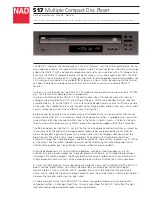
7
Blade height adjustment (Fig. 8)
Blade height adjustment is usually not necessary. How-
ever, if you notice that the blade edge is below the level of
the rear base or protrudes too far from the rear base, pro-
ceed as follows.
Loosen the eight installation bolts and the set plate
screws. Turn the adjusting screws clockwise to retract the
blade or counterclockwise to protrude it. After adjusting
the blade height, tighten the set plate screws and the
eight installation bolts securely.
Hex wrench storage (Fig. 10)
When not in use, store the hex wrench as shown in the
figure to keep it from being lost.
Nozzle assembly and joint (Accessory)
(Fig. 11, 12)
Nozzle assembly and joint are used when connecting the
tool to vacuum cleaner. When you wish to perform
cleaner operation, connect a vacuum cleaner to your
tool. To connect vacuum cleaner, remove the chip guide
from the tool. Place nozzle assembly and joint in its place
and then tighten screws to secure them.
Connect a hose of vacuum cleaner to the joint.
OPERATION
Planing operation (Fig. 13)
First, rest the tool front base flat upon the workpiece sur-
face without the blades making any contact. Switch on
and wait until the blades attain full speed. Then move the
tool gently forward. Apply pressure on the front of tool at
the start of planing, and at the back at the end of planing.
The speed and depth of cut determine the kind of finish.
The power planer keeps cutting at a speed that will not
result in jamming by chips. For rough cutting, the depth of
cut can be increased, while for a good finish you should
reduce the depth of cut and advance the tool more
slowly.
Front roller (Fig. 14)
When performing repeated cuts, the use of the front roller
enables quick and effortless return of the tool toward an
operator by raising the back end of the tool so that the
tool blades do not contact a workpiece and then sliding
tool on the front roller.
MAINTENANCE
CAUTION:
Always be sure that the tool is switched off and
unplugged before attempting to perform inspection or
maintenance.
Replacing carbon brushes
Remove and check the carbon brushes regularly.
Replace when they wear down to the limit mark. Keep
the carbon brushes clean and free to slip in the holders.
Both carbon brushes should be replaced at the same
time. Use only identical carbon brushes.
(Fig. 15)
Use a screwdriver to remove the brush holder caps. Take
out the worn carbon brushes, insert the new ones and
secure the brush holder caps.
(Fig. 16)
To maintain product SAFETY and RELIABILITY, repairs,
any other maintenance or adjustment should be per-
formed by Makita Authorized Service Centers, always
using Makita replacement parts.
ACCESSORIES
CAUTION:
These accessories or attachments are recommended for
use with your Makita tool specified in this manual. The
use of any other accessories or attachments might
present a risk of injury to persons. Only use accessory or
attachment for its stated purpose.
If you need any assistance for more details regarding
these accessories, ask your local Makita service center.
• Planer blade
• Triangular rule
• Nozzle assembly
• Joint
• Hex wrench
Содержание KP312S
Страница 2: ...2 14 16 15 13 17 18 20 19 1 2 3 4 5 6 7 8 1 2 6 7 8 10 9 11 12 13 5 4 3 ...
Страница 3: ...3 9 10 11 12 13 14 15 16 22 27 26 28 31 30 21 8 12 23 24 25 ...
Страница 52: ...52 ...
Страница 53: ...53 ...
Страница 54: ...54 ...
Страница 55: ...55 ...
Страница 56: ...Makita Corporation Anjo Aichi Japan Made in Japan 884478 990 ...








































